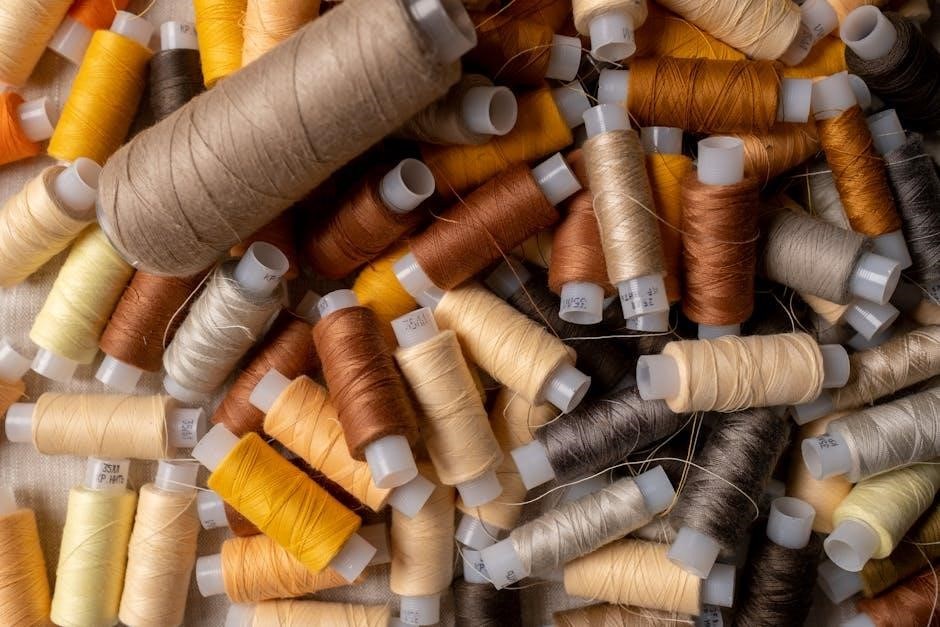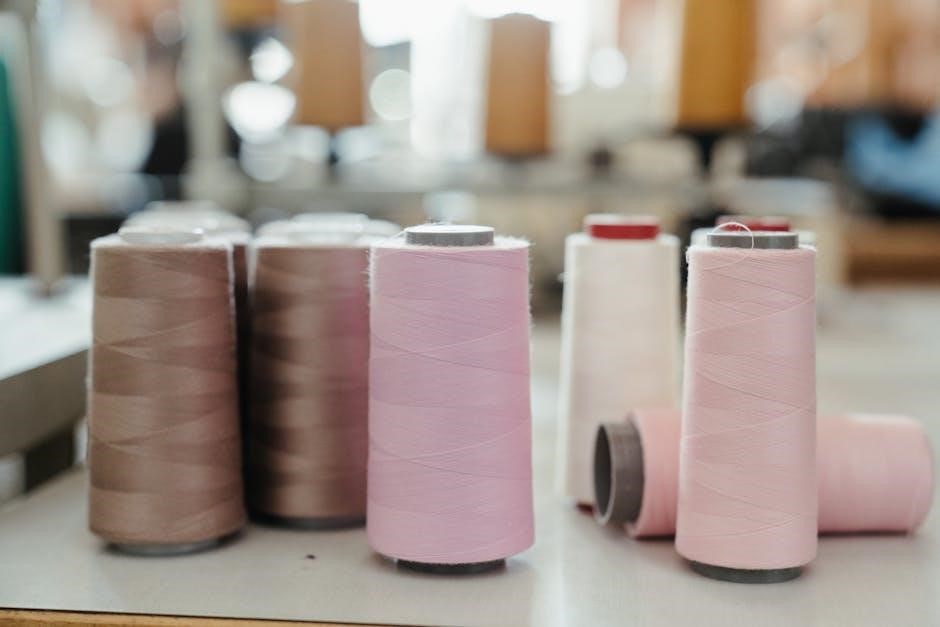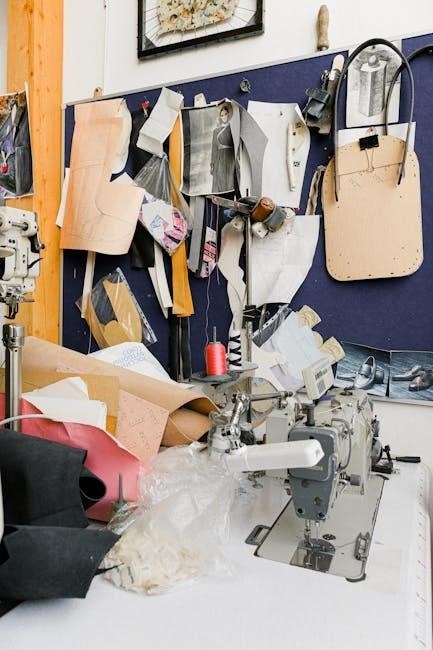PDF sewing patterns are digital templates you download and print at home, offering convenience and flexibility. They provide instant access, re-printing options, and cost-effective solutions for sewists of all levels.
1.1 What Are PDF Sewing Patterns?
A PDF sewing pattern is a digital file in Portable Document Format (PDF) that contains a sewing template and instructions; It allows users to download, print, and assemble the pattern at home. Unlike traditional paper patterns, PDFs are instantly accessible after purchase and can be reprinted as needed. They often include multiple sizes, trimless options, and layer printing for efficiency. Instructions are typically included, either as part of the PDF or separately, and may feature photos or illustrations. This format is popular for its convenience, cost-effectiveness, and flexibility, making it a favorite among sewists of all skill levels.
1.2 Benefits of Using PDF Sewing Patterns
PDF sewing patterns offer numerous advantages, including instant access after purchase, eliminating the need for physical storage. They can be printed multiple times, making them ideal for projects requiring different sizes or repeated use. This format also reduces waste, as you only print what’s necessary. Additionally, PDF patterns are cost-effective, with many free options available, and they allow for easy sharing and organization digitally. They are environmentally friendly and provide flexibility, as you can use them across devices. Many designers also offer re-download options, ensuring you never lose your patterns. These benefits make PDF sewing patterns a convenient and practical choice for sewists of all levels.
Downloading and Purchasing PDF Sewing Patterns
PDF sewing patterns are easily downloaded from designer websites, Etsy, or Blueprint. Purchases are instant, with options for free or paid patterns, and a simple checkout process.

2.1 Where to Find PDF Sewing Patterns
PDF sewing patterns are widely available online, with popular platforms like Etsy, Blueprint, and individual designer websites offering a vast selection. Many designers host their own shops, while others use marketplaces like Etsy for easy access. Additionally, Facebook groups and sewing communities often share free or discounted patterns. Some websites specialize in free patterns, making it easy for beginners to start without spending money. You can also find patterns through social media and sewing blogs, which often feature links to downloadable files. Whether you’re looking for free or paid options, there’s a wealth of resources available to suit your sewing needs and preferences.
2.2 How to Download a PDF Sewing Pattern
Downloading a PDF sewing pattern is a straightforward process. Once you’ve selected a pattern, click the download link provided by the seller or platform. Follow the checkout process, which may require creating an account or entering payment details. After completing the purchase, you’ll typically receive an email with a download link. Click this link to save the PDF file to your device. Some platforms allow direct downloads from their website after purchase. Ensure you have a stable internet connection and sufficient storage space. If the download doesn’t start automatically, check your email or account dashboard for instructions. Always verify the file format is PDF before opening to ensure compatibility with your devices.
2.3 Free vs. Paid PDF Sewing Patterns
Free and paid PDF sewing patterns offer distinct advantages. Free patterns are ideal for beginners or those on a budget, providing a cost-effective way to practice skills. They often include basic designs and are widely available on platforms like Etsy or designer websites. Paid patterns, however, typically offer higher quality, detailed instructions, and unique or specialized designs. They may include multiple sizes, layers for specific sizes, and advanced features like projector compatibility. While free patterns can be a great starting point, paid options often provide better value for serious sewists looking for professional results. Choose based on your skill level, project needs, and budget.

Printing PDF Sewing Patterns
Printing PDF sewing patterns requires careful attention to scaling and page setup. Use a laser printer for crisp lines and consider trimless options to save time and paper.
3.1 Understanding Page Setup and Scaling
Understanding page setup and scaling is crucial for accurately printing PDF sewing patterns. Ensure your printer is set to “Actual Size” in Adobe Acrobat to maintain the pattern’s true dimensions. Disable any scaling options like “Fit to Page” or “Shrink to Fit,” as these can distort the measurements. Check the margins and auto-rotation settings to ensure proper alignment. Some patterns include a test square on the first page to verify scaling accuracy—measure it with a ruler to confirm. Correct scaling ensures seamless assembly and accurate sewing results, so double-check these settings before printing to avoid costly mistakes or wasted materials.
3.2 Printing Tips for PDF Sewing Patterns
For successful printing of PDF sewing patterns, use a laser printer for crisp, durable prints. Print in draft mode to save ink and ensure “Actual Size” is selected in Adobe Acrobat. Measure the test square on the first page to confirm scaling accuracy. Set margins to zero and disable auto-rotation to prevent layout issues. Print in grayscale to reduce ink usage, as color is unnecessary for patterns. Avoid scaling options like “Fit to Page” to maintain true measurements. Refer to the pattern’s instructions for specific printing requirements, as some may include trimless pages or layered sizes. Proper printing ensures accurate assembly and sewing results.
3.3 Choosing the Right Printer for PDF Patterns
A laser printer is ideal for PDF sewing patterns due to crisp, high-quality prints and cost-effectiveness. Inkjet printers work but may be more expensive. Consider an A3 printer for large patterns or an all-in-one for scanning. Ensure your printer supports wireless or USB connectivity for easy file transfer. Check the pattern’s requirements, as some may need specific paper sizes. Laser printers, like Brother models, are recommended for their durability and efficiency, with less toner replacement needed. Choose a printer that aligns with your sewing frequency and pattern size preferences to enhance your PDF pattern experience.

Assembling PDF Sewing Patterns
Assembling PDF patterns involves trimming pages, aligning them using layout guides, and taping together. Ensure accuracy by matching markers and edges carefully for a seamless fit.
4.1 Trimming and Aligning Pages
Trimming and aligning pages are crucial steps in assembling PDF sewing patterns. Start by trimming the excess margins from each printed page, ensuring smooth edges for taping. Use the alignment markers or diamonds provided on each page to guide you. These markers help you match edges accurately, preventing misalignment. For best results, trim one side of each page first, then align and tape row by row. This method ensures the pattern pieces fit together seamlessly. Always refer to the layout guide included with your pattern for specific instructions, as some patterns may have unique trimming requirements or trimless options for convenience.
4.2 Taping Pages Together
Taping pages together is a straightforward process that requires precision. After trimming, align the pages using the markers or diamonds provided. For trimless patterns, skip trimming and align edges directly. Use clear tape, like Scotch tape, to secure the pages where they meet. Apply the tape along the edges, ensuring it lies flat to avoid air bubbles. Work row by row to maintain organization. Once all pages are taped, the pattern will form a complete layout; Double-check the alignment to ensure accuracy. This step is essential for creating a seamless template for cutting fabric. Proper taping ensures the pattern pieces fit together correctly, making the sewing process easier and more precise.
4.3 Using Layout Guides for Assembly
Layout guides are essential for accurately assembling PDF sewing patterns. These guides, often found on the first page, provide a visual map of how the pattern pieces fit together. They typically include alignment markers, such as diamonds or crosses, to help match edges seamlessly. By following the layout guide, you can ensure that the pages are correctly positioned and taped. This step prevents misalignment and saves time during assembly. Some patterns also offer layer printing options, allowing you to print only the size you need. Always refer to the guide before taping to achieve a precise and professional-looking result for your sewing project.

Cutting Fabric from PDF Sewing Patterns
Cutting fabric from PDF patterns involves tracing or directly cutting after assembling the pattern. Use tools like tissue paper or weights for accuracy and fit consistency.
5.1 Tracing vs. Cutting Directly from the Pattern
When working with PDF sewing patterns, you can either trace the pattern onto fabric or cut directly from the printed pages. Tracing is ideal for preserving the original pattern, especially if you plan to use it for multiple sizes or future projects. Use tissue paper or lightweight fabric to trace, ensuring accuracy and minimizing waste. Cutting directly is more convenient for single-size patterns, saving time and effort. However, it limits re-use. Choose the method based on your project needs and preference, balancing convenience with pattern preservation for future use.
5.2 Selecting the Correct Size
Selecting the correct size is crucial for a proper fit when using PDF sewing patterns. Always measure yourself accurately and compare your measurements to the pattern’s size chart. Most patterns include multiple sizes, so choose the one that aligns with your body measurements. Printing only the size you need can save paper and time. Some patterns offer layered printing, allowing you to select specific sizes. Double-check the size before cutting to avoid errors. If unsure, trace the pattern first or make a muslin prototype to test the fit. Accurate size selection ensures a professional finish and a comfortable garment.
5.3 Handling Multiple Sizes in a Single Pattern
Many PDF sewing patterns include multiple sizes, allowing you to choose the one that fits you best. To handle multiple sizes, look for patterns with layered printing options, which let you select specific sizes to print. This saves ink and paper by only printing the size you need. If layers aren’t available, trace the desired size onto tissue paper or directly onto fabric. For patterns with overlapping sizes, use the included measurement chart to identify your size. Store unused sizes digitally or print and organize them in labeled folders for future use. This flexibility ensures you can sew for yourself or others without reprinting the entire pattern.

Sewing with PDF Sewing Patterns
PDF sewing patterns simplify the sewing process with clear instructions and digital guides. Follow step-by-step tutorials, use digital or printed instructions, and ensure accurate seams for professional results.
6.1 Following Pattern Instructions
Following pattern instructions is crucial for successful sewing. PDF patterns include detailed guides, often with photos or illustrations, to help you understand each step. Print or view instructions on a device, depending on your preference. Pay attention to specific techniques, measurements, and fabric requirements. Organize the instructions alongside your printed pattern pieces to avoid confusion. Many designers offer digital tutorials or video guides for complex steps. Take your time to review the instructions thoroughly before starting to sew, ensuring accurate results and a professional finish. Properly following the instructions will help you achieve the best outcome for your handmade project.
6.2 Using Digital Instructions vs. Printed Instructions
Using digital instructions vs. printed instructions depends on personal preference and convenience. Digital instructions, accessed via a device, save paper and ink, allowing you to zoom in for details and easily navigate steps. Printed instructions provide a tangible reference, reducing screen time and offering a markup-friendly format. Many sewists print only the pattern pieces and view instructions digitally to conserve resources. Others prefer printing the entire document for ease of use. Both methods are effective; choose based on your workflow and sewing environment to ensure clarity and accessibility throughout your project.
6.3 Tips for Sewing Accurate Seams
For sewing accurate seams, use a walking foot or Teflon foot to guide fabric smoothly. Press seams as you go to ensure a crisp finish. Backstitch at the start and end of seams for durability. Maintain consistent seam allowances, trimming excess fabric to avoid bulk. Sew in the same direction, especially for knits, to prevent distortion. Use a rotary cutter and mat for precise fabric cutting. Align pattern pieces carefully before sewing, and double-check notches and markings. Test stitches on scrap fabric to ensure tension is correct. These tips will help you achieve professional-looking results and a flawless fit when working with PDF sewing patterns.

Storing PDF Sewing Patterns
Store digital PDFs in cloud storage or external drives for easy access. Printed patterns can be organized in binders, folders, or protective sleeves. Labeling ensures quick retrieval for future projects.
7.1 Organizing Digital PDF Files
Organizing digital PDF sewing patterns involves creating a structured system for easy access. Use cloud storage services like Google Drive or Dropbox to store and sync files across devices. Create folders by category, such as “Dresses,” “Tops,” or “Accessories,” and subfolders for sizes or designers. Rename files with descriptive names, including the pattern type and size. Regularly back up your files to an external hard drive to prevent data loss. Consider using software or apps designed for PDF management to tag and search patterns efficiently. This system ensures you can quickly locate and reuse your patterns without hassle.
7.2 Storing Printed Patterns
Properly storing printed PDF sewing patterns ensures they remain organized and protected. Use clear page protectors or large binders with dividers to keep patterns tidy and prevent damage. Manila envelopes or plastic bags can store individual patterns, with labels for easy identification. For bulk storage, consider filing cabinets with folders or desktop organizers. Rolling assembled patterns and securing them with elastic bands is another space-saving option. Store instructions separately in protective sleeves or binders. Labeling and categorizing patterns by type or size helps in quick retrieval. These methods protect your patterns from dust, moisture, and wear, ensuring they remain usable for future projects.
7.3 Re-Downloading Patterns from Designer Shops
Re-downloading PDF sewing patterns from designer shops is a convenient feature offered by most creators. Many designers provide access to purchased patterns through your account on their website, allowing you to retrieve files if they are lost or corrupted. To re-download, log into your account, navigate to the “Orders” or “Downloads” section, and select the pattern you wish to retrieve. Ensure your internet connection is stable during the process. This feature is especially useful if you change devices or experience computer issues. Always check the designer’s policies, as some may have time limits or restrictions on re-downloads. This ensures you can access your patterns whenever needed, providing peace of mind and flexibility for your sewing projects.

Troubleshooting Common Issues
Troubleshooting common issues with PDF sewing patterns involves resolving printing errors, fixing assembly mistakes, and addressing missing or corrupted files to ensure a smooth sewing experience.
8.1 Resolving Printing Errors
Printing errors with PDF sewing patterns can often be resolved by ensuring correct page setup and scaling. Check that “Actual Size” or “100%” is selected in print settings to maintain pattern accuracy. Verify that your printer is calibrated and updated with the latest drivers. If pages appear misaligned, trim borders carefully and realign during assembly. For issues like missing content, confirm the PDF is not corrupted by re-downloading it from the source. Using a laser printer is recommended for crisp, consistent results. Always preview the print layout to catch errors before printing. Addressing these common issues ensures your pattern prints correctly every time.
8.2 Fixing Assembly Mistakes
Assembly mistakes with PDF sewing patterns can be frustrating but are often easy to fix. If pages are misaligned, carefully retrim the edges and realign using the layout guide provided. Double-check that all pages are included and correctly ordered. For mismatched seams, gently remove tape and reposition pages, ensuring the pattern pieces fit seamlessly. If a page is missing, re-download the PDF from the designer’s shop. To prevent errors, use a ruler to trim evenly and tape pages incrementally, row by row. Patience and attention to detail are key to assembling patterns accurately. Always refer to the included layout guide for a flawless assembly process.

8.3 Addressing Missing or Corrupted Files
If a PDF sewing pattern file is missing or corrupted, start by checking your email and spam folder for the download link. Most designers allow re-downloads from their shop. Log into your account, locate the order, and re-download the file. If the issue persists, contact the designer’s customer support for assistance. Ensure your device has enough storage and that your PDF reader is up-to-date. For future security, consider backing up your patterns to cloud storage or an external drive. Regularly updating your software and maintaining a stable internet connection can also prevent file corruption during downloads.

Advanced Techniques for Using PDF Sewing Patterns
Explore advanced methods like layer printing for specific sizes, using projectors to shine patterns onto fabric, and large-format printing for seamless results without taping pages together.
9.1 Using Layer Printing for Specific Sizes
Layer printing allows you to select and print only the size you need from a multi-size PDF pattern. This feature saves time and ink by avoiding unnecessary prints. To use this technique, open the PDF in a compatible viewer, select the desired size layer, and print. Some patterns require Adobe Acrobat for layer functionality, while others may use separate files for each size. This method is especially useful for reducing paper waste and clutter. Always check the pattern instructions to ensure compatibility and proper setup. Layer printing streamlines the process, making it efficient and eco-friendly for sewists working on specific projects.
9.2 Projector Method for Sewing Patterns
The projector method is an innovative way to use PDF sewing patterns by projecting the design directly onto fabric. This technique eliminates the need for printing and taping paper. To use this method, you need a projector, a computer to display the PDF, and a surface to project onto. The pattern is opened on the computer and projected onto the fabric, allowing you to cut directly without printing. This method is ideal for large or complex patterns and saves time on assembly. Ensure the room is dimly lit for clarity and adjust the projector’s focus for accuracy. It’s a modern, efficient way to work with PDF patterns, especially for those comfortable with technology.
9.3 Large Format Printing Options
Large format printing is an advanced technique for PDF sewing patterns, ideal for projects requiring oversized templates. This method eliminates the need to print and assemble multiple pages, saving time and effort. Many office supply stores, like FedEx or Staples, offer large-format printing services, making it accessible even without a specialized printer. This option is perfect for patterns that exceed standard paper sizes, such as coats or upholstery designs. The result is a seamless, full-size pattern ready for cutting. For frequent use, investing in a large-format printer can enhance efficiency. This method is a game-changer for sewists tackling complex or large-scale projects with precision and ease.
Tips and Tricks for Working with PDF Sewing Patterns
Use tissue paper for tracing, save ink by printing only necessary pages, and customize patterns for a perfect fit. These tips enhance your sewing experience with PDF patterns.
10.1 Saving Ink When Printing Patterns
To save ink when printing PDF sewing patterns, consider using a laser printer, as they are more cost-effective and efficient than inkjet printers. Print only the pages necessary for your project, avoiding unnecessary pages like instructions or promotional content. Many patterns allow you to select specific sizes or layers, reducing ink usage by printing only what you need. Additionally, use draft mode or grayscale settings to minimize ink consumption. For instructions, opt to view them digitally on a tablet or smartphone instead of printing. These strategies help conserve ink while ensuring you have all the essential pieces for your sewing project.
10.2 Using Tissue Paper for Tracing
Using tissue paper for tracing is a practical method to preserve your PDF sewing patterns, especially when creating multiple sizes or variations. Trace the pattern pieces onto tissue paper, which is lightweight and easy to handle. This allows you to reuse the original printed pattern without cutting it, maintaining its integrity for future projects. Tissue paper is ideal for tracing intricate details and ensures accuracy. Simply place the tissue over the printed pattern and trace the lines with a pencil or marker. This technique is particularly useful for garments requiring different sizes or adjustments, making it a versatile tool for efficient sewing preparation.
10.3 Customizing Patterns for Better Fit
Customizing PDF sewing patterns ensures a perfect fit tailored to your measurements. Start by tracing the pattern onto tissue paper or directly onto fabric, allowing adjustments for length, width, or style. Use the included size chart to select the closest fit, then make alterations such as adding darts, adjusting sleeves, or modifying hems. Many patterns offer multiple sizes within one file, enabling you to blend sizes for a personalized fit. This method saves time and fabric, ensuring your final garment flatters your body. With practice, customizing becomes a seamless part of your sewing process, enhancing both comfort and confidence in your creations.
PDF sewing patterns empower creators with convenience, customization, and cost-efficiency, making sewing accessible and enjoyable for all skill levels while fostering creativity and confidence in every project.
11.1 Final Thoughts on Using PDF Sewing Patterns
PDF sewing patterns offer unparalleled convenience, flexibility, and accessibility, making them a valuable tool for sewists of all levels. Their digital format allows for instant access, re-printing, and customization, while reducing paper waste. The ability to store and organize patterns digitally or physically adds to their practicality. With a vast range of free and paid options, sewists can explore various styles and sizes without financial strain. Troubleshooting common issues, like re-downloading patterns or fixing assembly mistakes, is straightforward with designer support. Embrace PDF patterns to enhance your sewing journey, fostering creativity and confidence in every stitch.
11.2 Encouragement to Start Sewing with PDF Patterns
Embarking on your sewing journey with PDF patterns is an exciting and rewarding experience. These digital tools empower you to create custom garments and projects with ease, offering instant access and flexibility. Whether you’re a beginner or an experienced sewist, PDF patterns provide endless opportunities to explore new styles and techniques. Don’t hesitate to dive in—start with a simple project, and gradually build your skills. The sewing community is full of resources, tutorials, and support to guide you. With PDF patterns, the convenience and creativity are at your fingertips. Take the first step, and enjoy the joy of creating something truly unique and personalized.
